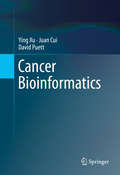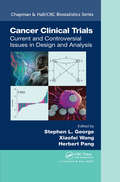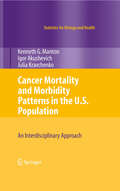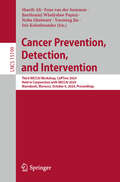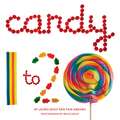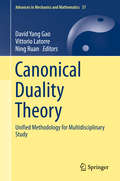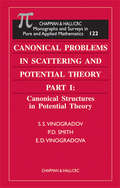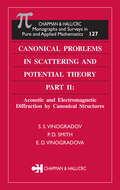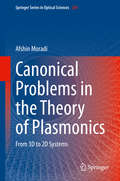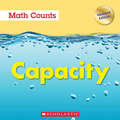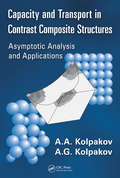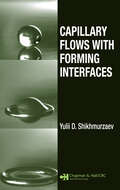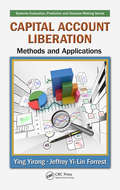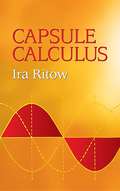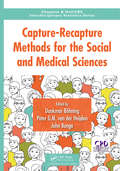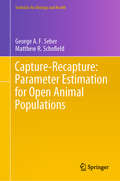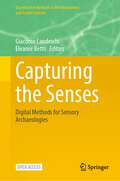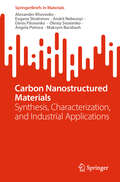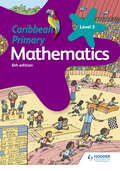- Table View
- List View
Cancer Bioinformatics
by Ying Xu Juan Cui David PuettThis book provides a framework for computational researchers studying the basics of cancer through comparative analyses of omic data. It discusses how key cancer pathways can be analyzed and discovered to derive new insights into the disease and identifies diagnostic and prognostic markers for cancer. Chapters explain the basic cancer biology and how cancer develops, including the many potential survival routes. The examination of gene-expression patterns uncovers commonalities across multiple cancers and specific characteristics of individual cancer types. The authors also treat cancer as an evolving complex system, explore future case studies, and summarize the essential online data sources. Cancer Bioinformatics is designed for practitioners and researchers working in cancer research and bioinformatics. It is also suitable as a secondary textbook for advanced-level students studying computer science, biostatistics or biomedicine.
Cancer Clinical Trials: Current and Controversial Issues in Design and Analysis (Chapman & Hall/CRC Biostatistics Series #91)
by Xiaofei Wang Stephen L. George Herbert PangCancer Clinical Trials: Current and Controversial Issues in Design and Analysis provides statisticians with an understanding of the critical challenges currently encountered in oncology trials. Well-known statisticians from academic institutions, regulatory and government agencies (such as the U.S. FDA and National Cancer Institute), and the pharmaceutical industry share their extensive experiences in cancer clinical trials and present examples taken from actual trials. The book covers topics that are often perplexing and sometimes controversial in cancer clinical trials. Most of the issues addressed are also important for clinical trials in other settings. After discussing general topics, the book focuses on aspects of early and late phase clinical trials. It also explores personalized medicine, including biomarker-based clinical trials, adaptive clinical trial designs, and dynamic treatment regimes.
Cancer Mortality and Morbidity Patterns in the U.S. Population: An Interdisciplinary Approach (Statistics for Biology and Health)
by Julia Kravchenko Igor Akushevich K. G. MantonThe purpose of this book is to examine the etiology of cancer in large human populations using mathematical models developed from an inter-disciplinary perspective of the population epidemiological, biodemographic, genetic and physiological basis of the mechanisms of cancer initiation and progression. In addition an investigation of how the basic mechanism of tumor initiation relates to general processes of senescence and to other major chronic diseases (e.g., heart disease and stroke) will be conducted.
Cancer Prevention, Detection, and Intervention: Third MICCAI Workshop, CaPTion 2024, Held in Conjunction with MICCAI 2024, Marrakesh, Morocco, October 6, 2024, Proceedings (Lecture Notes in Computer Science #15199)
by Sharib Ali Fons van der Sommen Bartłomiej Władysław Papież Yueming Jin Iris Kolenbrander Noha GhatwaryThis book constitutes the refereed proceedings of the Third International Workshop on Cancer Prevention Through Early Detection, CaPTion, held in conjunction with the 27th International Conference on Medical Imaging and Computer-Assisted Intervention, MICCAI 2024, in Marrakesh, Morocco, on October 6, 2024. The 22 full papers presented in this book were carefully reviewed and selected from 25 submissions. They were organized in topical sections as follows: Classification and characterization; detection and segmentation; cancer/early cancer detection, treatment and survival prognosis.
Candy 1 to 20
by Pam Abrams Bruce Wolf Laurie WolfReaders will devour this delicious counting book from lollipops to licorice strings, from 1 to 20!
Canonical Duality Theory: Unified Methodology for Multidisciplinary Study (Advances in Mechanics and Mathematics #37)
by Ning Ruan David Yang Gao Vittorio LatorreThis book on canonical duality theory provides a comprehensive review of its philosophical origin, physics foundation, and mathematical statements in both finite- and infinite-dimensional spaces. A ground-breaking methodological theory, canonical duality theory can be used for modeling complex systems within a unified framework and for solving a large class of challenging problems in multidisciplinary fields in engineering, mathematics, and the sciences. This volume places a particular emphasis on canonical duality theory's role in bridging the gap between non-convex analysis/mechanics and global optimization. With 18 total chapters written by experts in their fields, this volume provides a nonconventional theory for unified understanding of the fundamental difficulties in large deformation mechanics, bifurcation/chaos in nonlinear science, and the NP-hard problems in global optimization. Additionally, readers will find a unified methodology and powerful algorithms for solving challenging problems in complex systems with real-world applications in non-convex analysis, non-monotone variational inequalities, integer programming, topology optimization, post-buckling of large deformed structures, etc. Researchers and graduate students will find explanation and potential applications in multidisciplinary fields.
Canonical Problems in Scattering and Potential Theory Part 1: Canonical Structures in Potential Theory
by S.S. Vinogradov P. D. Smith E.D. VinogradovaAlthough the analysis of scattering for closed bodies of simple geometric shape is well developed, structures with edges, cavities, or inclusions have seemed, until now, intractable to analytical methods. This two-volume set describes a breakthrough in analytical techniques for accurately determining diffraction from classes of canonical scatterers
Canonical Problems in Scattering and Potential Theory Part II: Acoustic and Electromagnetic Diffraction by Canonical Structures (Monographs And Surveys In Pure And Applied Mathematics Ser.)
by S.S. Vinogradov P. D. Smith E.D. VinogradovaAlthough the analysis of scattering for closed bodies of simple geometric shape is well developed, structures with edges, cavities, or inclusions have seemed, until now, intractable to analytical methods. This two-volume set describes a breakthrough in analytical techniques for accurately determining diffraction from classes of canonical scatterers
Canonical Problems in the Theory of Plasmonics: From 3D to 2D Systems (Springer Series in Optical Sciences #230)
by Afshin MoradiThis book provides a systemic and self-contained guide to the theoretical description of the fundamental properties of plasmonic waves. The field of plasmonics is built on the interaction of electromagnetic radiation and conduction electrons at metallic interfaces or in metallic nanostructures, and so to describe basic plasmonic behavior, boundary-value problems may be formulated and solved using electromagnetic wave theory based on Maxwell’s equations and the electrostatic approximation.In preparation, the book begins with the basics of electromagnetic and electrostatic theories, along with a review of the local and spatial nonlocal plasma model of an electron gas. This is followed by clear and detailed boundary value analysis of both classical three-dimensional and novel two-dimensional plasmonic systems in a range of different geometries. With only general electromagnetic theory as a prerequisite, this resulting volume will be a useful entry point to plasmonic theory for students, as well as a convenient reference work for researchers who want to see how the underlying models can be analysed rigorously.
Canonical Ramsey Theory on Polish Spaces
by Vladimir Kanovei Marcin Sabok Jindřich ZapletalThis book lays the foundations for an exciting new area of research in descriptive set theory. It develops a robust connection between two active topics: forcing and analytic equivalence relations. This in turn allows the authors to develop a generalization of classical Ramsey theory. Given an analytic equivalence relation on a Polish space, can one find a large subset of the space on which it has a simple form? The book provides many positive and negative general answers to this question. The proofs feature proper forcing and Gandy-Harrington forcing, as well as partition arguments. The results include strong canonization theorems for many classes of equivalence relations and sigma-ideals, as well as ergodicity results in cases where canonization theorems are impossible to achieve. Ideal for graduate students and researchers in set theory, the book provides a useful springboard for further research.
Cantor und die Franzosen: Mathematik, Philosophie und das Unendliche (Mathematik im Kontext)
by Anne-Marie Décaillot Klaus VolkertEnde des 19. Jahrhunderts, als Georg Cantor in Halle die Mengenlehre entwickelte, korrespondierte der Mathematiker lebhaft mit zahlreichen französischen Fachkollegen. Diese Briefe nimmt die Autorin zur Grundlage, um im Detail zu beschreiben, wie die Briefpartner um mathematische Begriffe gerungen haben. Eingebettet in den historischen Kontext wird so ein faszinierender Moment in der Geschichte der Mathematik wieder lebendig.
Capacity (Math Counts: Updated Editions)
by Henry PluckroseAn introduction to capacity for the youngest readers!Math Counts series introduces young readers (grades K-3) to early math concepts. Real-world examples and corresponding photos make math concepts easy to grasp.Capacity is the word used to describe the most that a container can hold.
Capacity and Transport in Contrast Composite Structures: Asymptotic Analysis and Applications
by A. A. Kolpakov A. G. KolpakovIs it possible to apply a network model to composites with conical inclusions?How does the energy pass through contrast composites? Devoted to the analysis of transport problems for systems of densely packed, high-contrast composite materials, Capacity and Transport in Contrast Composite Structures: Asymptotic Analysis and Applications an
Capi, Sciamani, Tiranni, Dittatori, Imperatori e Presidenti: Verso la comprensione matematica dei Gruppi Sociali
by Francesco dell'IsolaQuesto libro mette in luce alcune idee matematiche che aiutano a spiegare una serie di aspetti importanti della dinamica dei gruppi sociali. Le idee e le tecniche utilizzate sono analoghe a quelle che hanno avuto tanto successo nella descrizione del comportamento dei sistemi meccanici lagrangiani: questo libro si rivolge a chiunque voglia comprendere l'unità intrinseca dei fenomeni naturali.
Capillary Flows with Forming Interfaces
by Yulii D. ShikhmurzaevCapillary Flows with Forming Interfaces explores numerous theoretical problems that arise in the mathematical description of capillary flows. It focuses on developing a unified approach to a variety of seemingly very different capillary flows of practical importance where classical fluid mechanics leads to nonphysical results.The book begin
Capital Account Liberation: Methods and Applications (Systems Evaluation, Prediction, and Decision-Making)
by Ying Yirong Jeffrey Yi-Lin ForrestAlong with the development of economic globalization, many countries have begun to relax their controls on their capital accounts. However, the recent financial crises in Latin American countries as well as the exchange rate crises in Southeast Asian countries have shown that there is major risk associated with capital account liberalization.This b
Capitalism, Degrowth and the Steady State Economy: Debating Future Economic Models (Palgrave Insights into Apocalypse Economics)
by Theodore P. LianosThis book examines the contemporary state of the capitalist economyand its future trajectory in a world characterized by multiple crises from population growth to ecological damage. Setting an understanding of modern capitalism in global historical context, chapters consider the uncertainty of capitalism’s future and argues that capitalism must adapt dramatically to survive.. The book examines the major problems that a capitalist system faces, including inequality, organized crime, uncontrolled technological development, polarizing geopolitics, food security and climate change. To address these multifaceted challenges andminimize the impact of capitalism in exacerbating them, the book discusses the potential viability of a ‘steady state’ economic model and a de-growth approach to the global economy. It also considers various alternative models for the future, including eco-socialism and participatory socialism. This book deftly weaves together perspectives on a wide variety of issues and will be a useful resource for scholars interested in Marxist economics and heterodox economics, political economy, economic development and economic thought.
Capsule Calculus
by Ira RitowThis brief introductory text presents the basic principles of calculus from the engineering viewpoint. Excellent either as a refresher or as an introductory course, it focuses on developing familiarity with the basic principles rather than presenting detailed proofs.Topics include differential calculus, in terms of differentiation and elementary differential equations; integral calculus, in simple and multiple integration forms; time calculus; equations of motion and their solution; complex variables; complex algebra; complex functions; complex and operational calculus; and simple and inverse transformations. Advanced subjects comprise integrations and differentiation techniques, in addition to a more sophisticated variety of differential equations than those previously discussed.It is assumed that the reader possesses an acquaintance with algebra and trigonometry as well as some familiarity with graphs. Additional background material is presented as needed.
Capture-Recapture Methods for the Social and Medical Sciences (Chapman & Hall/CRC Interdisciplinary Statistics)
by Dankmar Bohning Peter G.M. van der Heijden John BungeCapture-recapture methods have been used in biology and ecology for more than 100 years. However, it is only recently that these methods have become popular in the social and medical sciences to estimate the size of elusive populations such as illegal immigrants, illicit drug users, or people with a drinking problem. Capture-Recapture Methods for the Social and Medical Sciences brings together important developments which allow the application of these methods. It has contributions from more than 40 researchers, and is divided into eight parts, including topics such as ratio regression models, capture-recapture meta-analysis, extensions of single and multiple source models, latent variable models and Bayesian approaches. <P><P>The book is suitable for everyone who is interested in applying capture-recapture methods in the social and medical sciences. Furthermore, it is also of interest to those working with capture-recapture methods in biology and ecology, as there are some important developments covered in the book that also apply to these classical application areas.
Capture-Recapture: Parameter Estimation for Open Animal Populations (Statistics for Biology and Health)
by Matthew R. Schofield George A. SeberThis comprehensive book, rich with applications, offers a quantitative framework for the analysis of the various capture-recapture models for open animal populations, while also addressing associated computational methods. The state of our wildlife populations provides a litmus test for the state of our environment, especially in light of global warming and the increasing pollution of our land, seas, and air. In addition to monitoring our food resources such as fisheries, we need to protect endangered species from the effects of human activities (e.g. rhinos, whales, or encroachments on the habitat of orangutans). Pests must be be controlled, whether insects or viruses, and we need to cope with growing feral populations such as opossums, rabbits, and pigs. Accordingly, we need to obtain information about a given population’s dynamics, concerning e.g. mortality, birth, growth, breeding, sex, and migration, and determine whether the respective population is increasing , static, or declining. There are many methods for obtaining population information, but the most useful (and most work-intensive) is generically known as “capture-recapture,” where we mark or tag a representative sample of individuals from the population and follow that sample over time using recaptures, resightings, or dead recoveries. Marks can be natural, such as stripes, fin profiles, and even DNA; or artificial, such as spots on insects. Attached tags can, for example, be simple bands or streamers, or more sophisticated variants such as radio and sonic transmitters. To estimate population parameters, sophisticated and complex mathematical models have been devised on the basis of recapture information and computer packages. This book addresses the analysis of such models. It is primarily intended for ecologists and wildlife managers who wish to apply the methods to the types of problems discussed above, though it will also benefit researchers and graduate students in ecology. Familiarity with basic statistical concepts is essential.
Capturing the Senses: Digital Methods for Sensory Archaeologies (Quantitative Methods in the Humanities and Social Sciences)
by Eleanor Betts Giacomo LandeschiThis open-access book surveys how digital technology can contribute effectively to improving our understanding of the past, through a sensory engagement based on the evidence of material culture. In particular, it encourages specialists to consider senses and human agency as important factors in studying ancient space, while recognising the role played by digital tools in enhancing a human-centred form of analysis. Significant advances in archaeological computing, digital methods, and sensory approaches have led archaeologists to rethink strategies and methods for creating narratives of the past. Recent progress in data visualisation and implementation, as well as other nascent digital sensory methods, means that it is now easier to explore and experience ancient space from a multiscalar perspective, from the individual body or single building to the wider landscape.The chapters in Capturing the Senses: Digital Methods for Sensory Archaeologies present innovative methods for representing an embodied experience of ancient space, simulating (but not recreating) ancient behaviours and social interaction. Chapters cover topics including the potentials and pitfalls of visualising, recreating, and re-enacting/experiencing the senses in Virtual Reality environments and also digital reconstructions and auralisations of ancient spaces to study sound sensory perception. Overall, the book demonstrates that multisensory approaches can give a new perspective on how ancient spaces were intended to be used by inhabitants to fulfil a series of purposes including conveying messages and regulating movement. This is an open-access book.
Carbon Nanostructured Materials: Synthesis, Characterization, and Industrial Applications (SpringerBriefs in Materials)
by Maksym Barabash Alexander Khovavko Eugene Strativnov Andrii Nebesnyi Denis Filonenko Olexiy Sviatenko Angela PiatovaThis book provides a concise yet comprehensive look at carbon nanostructured materials, focusing on synthesis methodologies, applications, and fundamental principles. Based on extensive research conducted at the Gas Institute of the National Academy of Sciences of Ukraine, it offers a thorough examination of recent advancements in the field. The book describes various synthesis techniques, particularly emphasizing the continuous synthesis of carbon nanotubes (CNTs) on metal catalysts using chemical vapor deposition (CVD). It also discusses computational fluid dynamics (CFD) modeling of heating processes associated with carbon materials, crucial for understanding the thermodynamics of complex gas systems relevant to CNTs synthesis. Furthermore, the book discusses the structural properties of carbon nanomaterials, employing techniques such as Raman spectroscopy and optical microscopy. It provides detailed insights into the design and optimization of modern equipment for CNTs synthesis, with a focus on energy-efficient reactors for thermally expanded graphite (TEG) production. Beyond synthesis methodologies, the book explores applications of carbon nanomaterials, including their use in lithium-ion batteries, water purification systems, and nuclear reactors. It offers a serious examination of the potential environmental and technological implications of these materials. Comprising three distinct parts, each supplemented with comprehensive summaries, this book serves as a valuable resource for researchers, engineers, and graduate students in material science, thermal engineering, and nanotechnology. It presents empirical findings, theoretical insights, and practical applications, establishing itself as a valuable addition to the literature in the field of carbon nanostructured materials.
Cardinal Numbers: An Ohio Counting Book
by Marcia SchonbergThe author and the illustrator, who collaborated on the popular alphabet book B is for Buckeye, have teamed up again for Cardinal Numbers, the companion counting book for the great state of Ohio. This colorful and richly informative pictorial teaches children about numbers and math concepts by using people, places, and things specific to Ohio as examples. As the elementary age students begin to grasp these concepts, they learn more and more about their state in the process. Cardinal Numbers is a wonderful tool for educators, and along with B is for Buckeye, has become supplemental reading for every elementary-school classroom in Ohio.
Care in Mathematics Education: Alternative Educational Spaces and Practices (Palgrave Studies in Alternative Education)
by Anne WatsonThis book investigates the process of care in mathematics teaching. The author proposes transformative educational spaces in which learning mathematics, rather than consisting of a repetitive grind of exercises and facts, can become a part of learner identity. This book describes examples of mathematics teachings in a wide range of contexts and pedagogies, coordinated to identify common features where care for mathematical learning and thinking is combined with care for learners. Along with detailing caring mathematics education practices in alternative spaces, the author demonstrates similar practices alive even with the current mainstream spaces of acquisition and performance. Care is integrated through listening, and developing responsive and trusting relationships. It will be of interest to scholars of mathematics education, as well as pre-service and in-service teachers and teacher educators.
Caribbean Primary Mathematics Book 3 6th edition
by Karen MorrisonMake teaching and learning mathematics relevant and enjoyable with the best-known Primary mathematics series in the Caribbean updated and revised for the 21st Century by practising teachers, with a new focus on self-directed learning, problem -solving and raising standards.- Ensure all requirements of primary schools in all Caribbean territories from kindergarten to primary school exit examination level are covered. - Engage students and make maths more relevant with real-life situations used throughout the book, including the front cover, showing Mathematics in action.- Reinforce knowledge and encourage progression with Assessment Bank, available separately to compliment the topics covered in this series.- Encourage students to understand and build their own learning with all key skills and concepts clearly introduced in sequence, demonstrating links between mathematical strands and other curriculum subjects.
